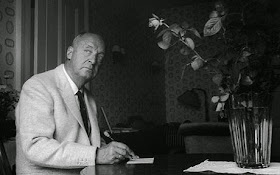 |
| Are we having fun yet? Edmund Wilson, aka "Bunny" (derived from plum bun) flayer of detective, supernatural and fantasy fiction |
There were, however, a few people who wrote Wilson agreeable letters on the matter. One of these individuals was the emigre Russian novelist Vladimir Nabokov (1899-1977). The same month that Edmund Wilson's first essay on detective fiction appeared in the New Yorker, Nabokov, who in 1940 had begun what was to be a correspondence of three decades with Wilson, wrote his friend:
I liked very much your article on detective stories. Of course, Agatha is unreadable--but Sayers, whom you do not mention, writes well. Try Crimes Advertises [Murder Must Advertise]. Your attitude to detective writing is curiously like my attitude towards Soviet literature, so that you are on the whole absolutely right.
Nabokov then proceeded to quote to "Bunny" (Edmund Wilson's rather unexpected nickname) excerpts of poor writing from tales collected in Eugene Thwing's World's Best 100 Detective Stories (1929). He predicted they would give the sensitive and superior Wilson "slight nausea."
 |
| Valdimir Nabokov praised H. F. Heard's A Taste for Honey as "very nicely written"-- "though the entomological part is of course all wrong" |
Unlike Wilson, however, Nabokov himself in fact had a certain partiality toward detective fiction (the well-written ones, of course), as his favorable reference to Dorothy L. Sayers suggests. The previous year, he wrote Wilson that after some excruciating dental surgery
I was lying on my bed groaning...yearning for a good detective story--and at that very moment the Taste for Honey sailed in...Mary [McCarthy, Wilson's then wife, like him a prominent literary critic and author] was right, I enjoyed it hugely--though the entomological part is of course all wrong (in one passage he [the author, H. F. Heard] confuses the Purple Emperor, a butterfly, with the Emperor moth). But it is very nicely written. Did Mary see the point of the detective's name at the very end? I did.
Nabokov may have liked H. F. Heard's beekeeper mystery, still in print today, yet that same year he complained that he "did not think much of" John Dickson Carr's The Judas Window, also still in print today, which Mary McCarthy had read. The way in which the murder was accomplished he deemed droll after a fashion but unconvincing, and he admonished McCarthy, "you ought to have found something better."
 |
| Mary McCarthy enjoyed detective fiction, no matter what her persnickety plum bun husband had to say about it (she panned Sayers' Gaudy Night, however) |
For his part Wilson admitted in a 1944 letter to Nabokov that "I have been getting dozens of letters from [detective fiction] addicts protesting against my article and only three so far approving it." Wilson's 1945 follow-up essay in the New Yorker, "Who Cares Who Killed Roger Ackroyd?", did tackle the fiction of Dorothy L. Sayers, specifically her bell ringer mystery The Nine Tailors; but Wilson, in contrast with Nabokov, was wholly dismissive of the highest-browed Crime Queen:
I had often heard people say that Dorothy Sayers wrote well, and I felt that my correspondents [concerning his first essay] had been playing her as their literary ace. But, really, she does not write very well: it is simply that she is more consciously literary than most of the other detective story writers and she thus attracts attention in a field which is mostly on a sub-literary level. In any serious department of fiction, her writing would appear not to have any distinction at all.
Of The Nine Tailors Wilson declared damningly that he found it "one of the dullest books I have ever encountered in any field." He likened the beloved mystery novel to "an encyclopedia article on campanology."
At least Sayers' fans have the satisfaction of knowing that Vladimir Nabokov was an admirer of Sayers' writing (though not Christie's)--in French translation, anyway!
Note: Letter quotations in this piece are drawn from Simon Karlinsky, ed., Dear Bunny, Dear Volodya: The Nabokov-Wilson Letters, 1940-1971 (rev. ed., 2001).
 |
| Iron bells! What a world of solemn thought their monody compels! |







































